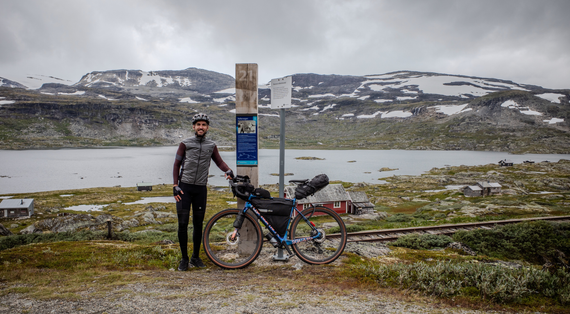Ultra-cyclist and Selle San Marco ambassador Peppe Esposto started travelling on a bike more than 15 years ago when the concept of bikepacking as we know it today was unknown. Cycling has always been Peppe’s greatest passion and, over time, he has managed to turn it into a profession. Throughout the years, he has ridden a whole host of different bikes and setups that focused on ultra-cycling and bikepacking, to the point of launching his own professional project: peppeesposto.cc, a platform dedicated to bike tourism and training to become an independent cyclist. With his experience, he has helped us identify some fundamentals needed for bikepacking and travelling by bike.
The importance of planning
Planning is one of the fundamental aspects of long distance cycling, often arising from the desire to test ourselves, the need for escape, or the dream of reaching a specific goal. Organising a cycling trip can be complex and time-consuming, especially at the beginning. However, if done right, it can greatly reduce the risks associated with the adventure. On any bike ride, safety must be the top priority, and to ensure this, it’s necessary to carefully plan the route, assess the risks, and try to anticipate the unexpected, while always remaining calm. You should always keep in mind that you’ll often find yourself sharing the road with cars and that the attention of drivers can be poor. That’s why wearing a helmet properly and making yourself clearly visible with front and rear lights is absolutely essential.
Prepare for the worst, hope for the best
Weather conditions can also significantly impact your trip, so it’s important to assess them carefully. It’s also good to make sure you always have sufficient water and food available, protect your skin with sunscreen, and try to avoid the hottest hours for cycling. Plan your stops carefully and, if you are travelling in a country with amazing food and drink like Italy, take lots of breaks in some good restaurants as a reward and to refuel. Your body is the engine, so it’s crucial to take care of it.
Use technology to your advantage
Thankfully, there are many apps and software that make detailed planning of your trips much easier, allowing you to plan stages and know the expected distance and climbing of each day. There are a number of top quality bike computers on the market today and they’ve transformed the world of navigation. Just load your route onto a device, attach it to your handlebars, and follow the route on the screen. These computers offer a wealth of useful information during the journey, such as distance travelled, remaining distance, average speed, details of climbs and descents, and elevation profile. Knowing your average speed is essential for calculating travel times, a crucial aspect when planning a cycling trip. Over the years, I’ve relied more and more on these technologies and have become an expert in planning bicycle trips. I’ve planned thousands of kilometres of routes, including details on maps and logistics, and continues to carefully plan each of his trips.
If you are a beginner, the advice is to plan your stages in a way that finds the right balance between exercise, fun, and adventure. It is good to remember that it is not the distance travelled that counts, but the way you travel it. Approach the journey with a relaxed and positive mindset and you’ll attract positive experiences.

Bikepacking equipment
Bikepacking has profoundly changed the traditional approach to bike travel, mainly due to the use of panniers and luggage racks. Bikepacking bags can be mounted on almost any type of bicycle without the need for a luggage rack, making them extremely versatile. With proper care, they can be adapted to both road and mountain bikes, allowing you to carry the equipment you need for a weekend with friends or for long rides. Minimalism is an important concept in bikepacking, as the reduced space in bags leads to careful consideration of each piece of equipment that you plan to carry. Each item must be essential and potentially useful in different situations.
Keeping your gear dry
An effective trick to keeping your gear dry is to organise the space inside the bags carefully and wrap your items, especially clothing, in plastic bags. Despite the fact that bags are designed to be waterproof, it's always better to add an extra layer of protection where possible, -ensuring that you always have dry clothes at hand. This advice proves to be valuable in any climate as you never know when the weather will suddenly change. Separating clothes into bags also helps keep them organised and easier to find when needed. Another useful recommendation is to go for lightweight material, as the less weight you carry, the less fatigue you will experience during the trip.
Safety first
A good first aid kit is absolutely vital when travelling, especially when doing so by bike. These kits, easily available online at affordable prices, include everything needed to deal with the most common medical emergencies. In addition to the first aid kit, it is very important to carry an emergency blanket with you at all times. This simple, inexpensive tool can make all the difference in protecting against hypothermia.
For longer adventures, it is also advisable to carry some basic medicines, such as painkillers and anti-inflammatories, to handle minor medical emergencies. Finally, it is good to make sure that you always have a charged and protected mobile phone with you so that you can call for help. This is a big reason why it‘s not recommended to use your mobile phone for navigating while cycling.
Selle San Marco bikepacking bags
Acquiring the right experience to fully understand these ideas takes time. It took me more than a decade to refine them, remembering my early trips when I carried an excessive amount of unnecessary items. Now, with optimised equipment, I manage to travel for weeks or even months with the same gear, proving how crucial the minimalist approach to bikepacking is. A faithful travelling companion of mine is the bikepacking bag set from Selle San Marco. Put to the test during my explorations on challenging routes, it passed with flying colours. These products stand out for their extraordinary robustness and lightness, essential characteristics for tackling long bikepacking trips. The quality of the materials and the attention to construction details made each component of the set reliable in the most challenging situations, from long climbs to technical downhill sections. On top of this, the ability to adapt to various types of bicycles and setups, coupled with the ease of packing and unpacking, have made bikepacking much smoother. The balance between functionality and design left a positive impression, confirming Selle San Marco's reputation as a brand capable of combining performance and aesthetics in products designed for the most demanding bikepackers and cyclists. My set consists of a saddle bag, frame bag, handlebar bag, and top tube bag.
Saddle bag
The saddle bag is installed under the saddle and offers easy access. I usually store objects there that can be accessed quickly. It is characterised by the fact that it can be easily opened by simply releasing the rear clip. Generally, in this bag, you can store warm clothing that you may need while riding. Selle San Marco offers the Saddle Bag 7L and the Saddle Bag 13L in the range, depending on the different needs.
Frame Bag
I've attached the frame bag to the frame, which can vary in shape and size. This bag can be small, leaving the lower frame space free for water bottles, or it can be a full frame bag that covers the entire frame triangle. In the latter case, you gain in carrying capacity, but you must find alternative solutions for your water bottles, such as mounting them on the fork or using a water backpack.
The frame bag can hold bivouac equipment and rain jackets. Generally, heavy items such as multi-tools or extra bits and pieces for travelling can be stored in the lower part of this bag. This bag is easily accessible, especially if, as in the model offered by Selle San Marco, it has a large zip that allows you to open it comfortably while cycling. Selle San Marco offers a choice of 5 different sizes for this model: Frame Bag 6L, Frame Bag 5L, Frame Bag 4L, Frame Bag 3L, Frame Bag 2L.
Handlebar Bag
The third bag is the handlebar bag. Although similar bags were already used in classic travel set-ups, bikepacking bags have been adapted to fit without additional supports, making them compatible with any type of handlebar, whether for mountain bikes, road bikes, or gravel bikes. There are different sized bags, from the smallest, suitable for weekends, such as Selle San Marco's Handlebar Bag 2L which is waterproof, compact, and lightweight through to larger bags, ideal for carrying more equipment.
Top tube bag and other bags
Another noteworthy bag in the bikepacking world is the Top Tube Bag, which attaches to the top of the frame. Available in various sizes, it is particularly practical for storing items to be used while riding, such as energy bars or other small accessories. On top of all these choices, there are several other types of bags, such as bottle bags and fork mounts. It is also important to consider the new hybrid models that are emerging in the sector, such as removable pannier racks and solutions that find a compromise between traditional and bikepacking bags.
Other useful tips
If you haven't yet had the opportunity to experience bikepacking, my advice is to take your bike and set off on an adventure. Getting out of your comfort zone and immersing yourself in the adventurous spirit of bikepacking allows you not only to enrich yourself but also to make a positive contribution to society.
For those who want to experience cycling without the burden of planning, attending one of the many events organised in Italy can be a great place to start. Renowned bikepacking events such as the Tuscany Trail, gravel weekends such as the Unpaved Roads events, or on-the-road bikepacking adventures such as The Grand Escape, offer unique opportunities to immerse yourself in adventure cycling culture.
Most of these events provide participants with a predefined route, allowing them to familiarise themselves with the route in advance and ensure that the stages, which each participant plans themselves, are suitable for their level of fitness. The beauty of these events is that they are not competitions; there is no time limit, allowing everyone to proceed at their own pace. If you’re looking for information and resources on bikepacking, the web offers a wide range of content to suit your needs.
The experiences I've had over the past few years have enriched my personal and professional background. I've collected and shared on my blog peppeesposto.cc, where I tell of the adventures, challenges, and wonderful discoveries made along the way. If you are interested, my invitation is to browse the site by subscribing to the newsletter, hoping that my stories will inspire you to embark on new cycling adventures.





















